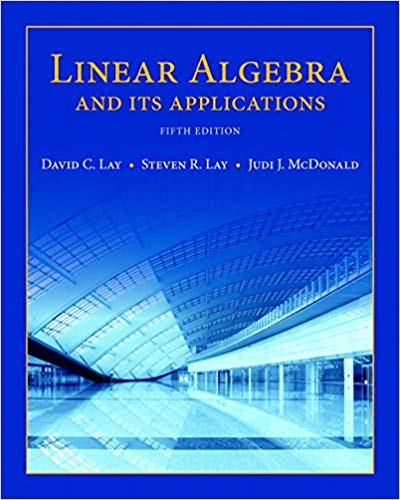
Linear Algebra and Its Applications, 5th Edition
Authors: David C. Lay, Steven R. Lay, Judi J. McDonald
ISBN-13: 978-0321982384
We have solutions for your book!
See our solution for Question 5E from Chapter 4.SE from Lay's Linear Algebra and Its Applications, 5th Edition.
Problem 5E
Chapter:
Problem:
0
Step-by-Step Solution
Given Information
We are given with following polynomials:\[\begin{array}{l}{{\bf{p}}_1}(t) = 1 + t,\\{{\bf{p}}_2}(t) = 1 - t,\\{{\bf{p}}_3}(t) = 4,\\{{\bf{p}}_4}(t) = t + {t^2},\\{{\bf{p}}_5}(t) = 1 + 2t + {t^2}\end{array}\]Also, \[S=\left\{\mathbf{p}_{1}, \mathbf{p}_{2}, \mathbf{p}_{3}, \mathbf{p}_{4}, \mathbf{p}_{5}\right\}, \text { and } H=\operatorname{Span}\left\{\mathbf{p}_{1}, \mathbf{p}_{2}, \mathbf{p}_{3}, \mathbf{p}_{4}, \mathbf{p}_{5}\right\}\]We have to find a basis for H
Step-1: Check for linear combination of $p_1$ and $p_2$
Let there be a scalar $c_1$ such that \[\begin{aligned} \mathbf{p}_{2} &=c_{1} \mathbf{p}_{1} \\ 1-t &=c_{1}(1+t) \\ 1-t &=c_{1}+c_{1} t \end{aligned}\]Upon solving: \[c_{1}=1, \text { and } c_{1}=-1\]Therefore,
$p_1$ and $p_2$ are independent
Step-2: Check for linear combination of $p_3$
Let there be a scalar $c_1$ and $c_2$ such that \[\begin{aligned} \mathbf{p}_{3} &=c_{1} \mathbf{p}_{1}+c_{2} \mathbf{p}_{2} \\ 4 &=c_{1}(1+t)+c_{2}(1-t) \\ 4 &=c_{1}+c_{2}+\left(c_{1}-c_{2}\right) t \end{aligned}\]Upon solving: \[c_{1}=2, \text { and } c_{2}=2\]Therefore,
$ p_3 $can be obtained from $p_1$ and $p_2$
Step-3: Check for linear combination of $p_4$
Let there be a scalar $c_1$, $c_2$ and $c_3$ such that \[\begin{aligned} \mathbf{p}_{4} &=c_{1} \mathbf{p}_{1}+c_{2} \mathbf{p}_{2}+c_{3} \mathbf{p}_{3} \\ t+t^{2} &=c_{1}(1+t)+c_{2}(1-t)+c_{3}(4) \\ &=c_{1}+c_{2}+4 c_{3}+\left(c_{1}-c_{2}\right) t \end{aligned}\]Since there is no $t^2$ term on the right, Therefore,
$ p_4 $ is an independent vector
Step-4: Check for linear combination of $p_5$
Let there be a scalar $c_1$, $c_2$, $c_3$ and $c_4$ such that \[\begin{aligned} \mathbf{p}_{5} &=c_{1} \mathbf{p}_{1}+c_{2} \mathbf{p}_{2}+c_{3} \mathbf{p}_{3}+c_{4} \mathbf{p}_{4} \\ 1+2 t+t^{2} &=c_{1}(1+t)+c_{2}(1-t)+c_{3}(4)+c_{4}\left(t+t^{2}\right) \\ &=c_{1}+c_{2}+4 c_{3}+\left(c_{1}-c_{2}+c_{4}\right) t+c_{4} t^{2} \end{aligned}\]Upon Solving: \[c_{1}=1, c_{2}=0, c_{3}=0, \text { and } c_{4}=1\]Therefore,
$ p_5 $ is dependent vector
Step-5: The Basis
The basis is formed by only independent vectors, so the basis for H is:
\[\left\{\mathbf{p}_{1}, \mathbf{p}_{2}, \mathbf{p}_{4}\right\}\]
We are given with following polynomials:\[\begin{array}{l}{{\bf{p}}_1}(t) = 1 + t,\\{{\bf{p}}_2}(t) = 1 - t,\\{{\bf{p}}_3}(t) = 4,\\{{\bf{p}}_4}(t) = t + {t^2},\\{{\bf{p}}_5}(t) = 1 + 2t + {t^2}\end{array}\]Also, \[S=\left\{\mathbf{p}_{1}, \mathbf{p}_{2}, \mathbf{p}_{3}, \mathbf{p}_{4}, \mathbf{p}_{5}\right\}, \text { and } H=\operatorname{Span}\left\{\mathbf{p}_{1}, \mathbf{p}_{2}, \mathbf{p}_{3}, \mathbf{p}_{4}, \mathbf{p}_{5}\right\}\]We have to find a basis for H
Step-1: Check for linear combination of $p_1$ and $p_2$
Let there be a scalar $c_1$ such that \[\begin{aligned} \mathbf{p}_{2} &=c_{1} \mathbf{p}_{1} \\ 1-t &=c_{1}(1+t) \\ 1-t &=c_{1}+c_{1} t \end{aligned}\]Upon solving: \[c_{1}=1, \text { and } c_{1}=-1\]Therefore,
$p_1$ and $p_2$ are independent
Step-2: Check for linear combination of $p_3$
Let there be a scalar $c_1$ and $c_2$ such that \[\begin{aligned} \mathbf{p}_{3} &=c_{1} \mathbf{p}_{1}+c_{2} \mathbf{p}_{2} \\ 4 &=c_{1}(1+t)+c_{2}(1-t) \\ 4 &=c_{1}+c_{2}+\left(c_{1}-c_{2}\right) t \end{aligned}\]Upon solving: \[c_{1}=2, \text { and } c_{2}=2\]Therefore,
$ p_3 $can be obtained from $p_1$ and $p_2$
Step-3: Check for linear combination of $p_4$
Let there be a scalar $c_1$, $c_2$ and $c_3$ such that \[\begin{aligned} \mathbf{p}_{4} &=c_{1} \mathbf{p}_{1}+c_{2} \mathbf{p}_{2}+c_{3} \mathbf{p}_{3} \\ t+t^{2} &=c_{1}(1+t)+c_{2}(1-t)+c_{3}(4) \\ &=c_{1}+c_{2}+4 c_{3}+\left(c_{1}-c_{2}\right) t \end{aligned}\]Since there is no $t^2$ term on the right, Therefore,
$ p_4 $ is an independent vector
Step-4: Check for linear combination of $p_5$
Let there be a scalar $c_1$, $c_2$, $c_3$ and $c_4$ such that \[\begin{aligned} \mathbf{p}_{5} &=c_{1} \mathbf{p}_{1}+c_{2} \mathbf{p}_{2}+c_{3} \mathbf{p}_{3}+c_{4} \mathbf{p}_{4} \\ 1+2 t+t^{2} &=c_{1}(1+t)+c_{2}(1-t)+c_{3}(4)+c_{4}\left(t+t^{2}\right) \\ &=c_{1}+c_{2}+4 c_{3}+\left(c_{1}-c_{2}+c_{4}\right) t+c_{4} t^{2} \end{aligned}\]Upon Solving: \[c_{1}=1, c_{2}=0, c_{3}=0, \text { and } c_{4}=1\]Therefore,
$ p_5 $ is dependent vector
Step-5: The Basis
The basis is formed by only independent vectors, so the basis for H is:
\[\left\{\mathbf{p}_{1}, \mathbf{p}_{2}, \mathbf{p}_{4}\right\}\]